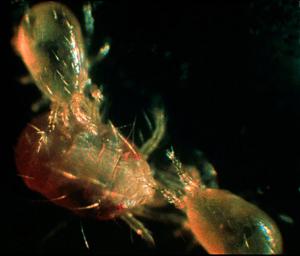Contents
Identification
Development Model
Predator Mite Release Model
Management
and Biocontrol Guidelines
Fact
Sheet (requires Acrobat Reader 3.x or
above to read and print. Click below to download the free "Reader".)

Registered
Insecticides
References
[Insect
Management]
[Home] |
|
 |
The most common predator mite found in
mint is Neoseiulus fallacis (=Ambyleius fallacis). This predator is
about 0.25 to 0.5 mm long, yellow to almost translucent and "pear-shaped". These
mites overwinter as adult females in the soil or crop debris. Adults become active in the
spring and lay eggs on leaves. Eggs hatch in 2 to 3 days and larva feed for 1 to 2 days
before molting to the protonymph stage. This stage consumes about 2 prey and completes
development to the deutonymph stage in 1 to 2 days. The deutonymph stages lasts 1 to 2
days before molting to the adult. Adult females consume nearly 2 prey/day during a 5 to 6
week period. Females consume about 75 to 80 total prey and lay about 33 eggs during her
lifetime. The life cycle from egg to adult requires about 6 days and there are at least 10
generations each year. |
Predator Mites Feeding
on Spider Mite |
View the Fact
Sheet For More Information |
This section contains information on
identification and use of predator mites for spider mite control in peppermint. View
the Fact Sheet and
see Morris 1998, Morris et al.
1996, Morris et al. 1999, and Morris et al. 2000 for specific information on biology of
these predators. |

